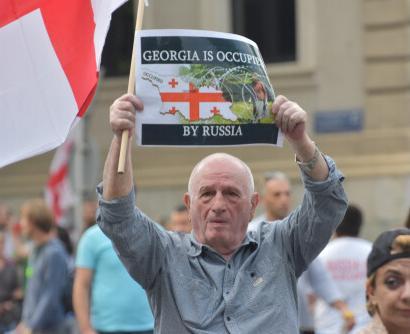Abstract: Commentators and policymakers are increasingly recognizing the security threat posed by corruption. However, viewing corruption through the lens of national security poses risks that include escalating tensions. This short essay argues that a multilateral response is needed to address the security threats posed by corruption, and proposes why the OSCE is the ideal forum for such an endeavor.
Bottom-line-up-front: Corruption poses a serious threat to security, a fact which has only recently been recognized by national policymakers. Multilateral responses are needed to tackle the security threats posed by corruption.
Problem statement: Why corruption should be framed as a shared security threat rather than a national security threat that risks raising tensions?
So what?: This threat should foremost be addressed from a multilateral level due to the transnational nature of corruption, so as to prevent escalation. While not being the most obvious choice, the OSCE offers several advantages as a forum.
Why the OSCE Should Lead the Response to the Security Risks posed by Corruption
.
Download • 838KB

Source: www.shutterstock.com/MarinaNov
“Corruption does not stop at national borders; it is a threat to our shared security.”
Thomas Greminger, former OSCE Secretary-General
Corruption as a Security Threat
Corruption is perpetual. In the past months, several governments have succumbed to corruption-related scandals, while the involvement of world leaders and powerful enablers in shadowy financial networks was widely exposed in the “Pandora Papers” leak. In such cases, a debate always arises on what exactly corruption amounts to. A narrow definition could limit itself to traditional offences such as bribery or illicit enrichment, whereas a wider definition could also encapsulate cronyism and tax avoidance practices.
Corruption is a slippery concept and not only in a definitional sense. It slides into other policy areas, acting as an impediment to progress, such as economic development or the achievement of gender equality. A relatively new outlook has become widespread – namely that corruption is a security threat.
This framing has been championed by the international anti-corruption NGO Transparency International[1] and other leading scholars and experts in the field and it doesn’t require much imagination to see why. Corruption does not only pose risks to the defence and security sector itself – which is already vulnerable due to what are often long, high-price and confidential procurement processes – but there are other direct and indirect linkages.
Corruption does not only pose risks to the defence and security sector itself – which is already vulnerable due to what are often long, high-price and confidential procurement processes – but there are other direct and indirect linkages.
Corrupt state officials can open proverbial doors for non-state actors, ranging from kleptocratic networks to transnational organized criminal groups, enabling their destabilizing interests to infiltrate policy outcomes. Sarah Chayes has extensively researched how the public’s outrage in response to corruption can transform into violent extremism.[2] Lastly, commentators have drawn a link between the collapse of the Afghan government at the hands of the Taliban and the failure to curb rampant corruption there.[3]
States are Acting – and the OSCE Can Step Up!
States are beginning to get in on the act. This June, President Biden issued a Memorandum recognizing corruption as a risk to national security and directing all US government departments and agencies to make recommendations towards combatting it. In July, the Russian Federation updated its National Security Strategy, which included several provisions on linkages between security and corruption. There is plenty of reason to believe that corruption will soon join the ranks of other pressing issues which cumulatively threaten to undermine global security.
If so, it will be crucial to have a multilateral body that is prepared to handle the task. While the Organisation for Economic Co-operation and Development and the United Nations Office on Drugs and Crime have prominent mandates on corruption, they arguably lack the security specialization.
It is argued here that the OSCE can step into this vacuum and play a leading role. The Office of the Co-ordinator of OSCE Economic and Environmental Activities (OCEEA) already does admirable work on combatting corruption – see its Handbook on Combating Corruption – but under the unified budget, it typically receives a smaller allocation of funds in comparison to other Offices.
The unique institutional setup of the OSCE offers many advantages. Firstly, it already has a strong mandate to explore the links between corruption and security. Following the end of the Cold War and the 1992 Helsinki Summit, the OSCE transformed into a body with a multi-dimensional focus on security, including the economic-environmental dimension which OCCEA supports. In the 2003 Maastricht OSCE Strategy Document for the Economic and Environmental Dimension, OSCE participating States recognized that corruption is among the factors contributing to global threats such as terrorism, violent extremism, transnational organized crime and trafficking of all kinds, and in the 2012 Dublin Declaration, that corruption can undermine security and stability.
Following the end of the Cold War and the 1992 Helsinki Summit, the OSCE transformed into a body with a multi-dimensional focus on security, including the economic-environmental dimension which OCCEA supports.
Secondly, the OSCE is foremost a regional security organization. Transborder corruption flows frequently affect one or more OSCE participating States; there is evidence that corruption is a phenomenon strongly shaped by regional factors and those anti-corruption achievements can have significant regional spillovers.[4] Many OSCE participating States could be classified as currently what Professor Alina Mungiu-Pippidi has termed “borderliners” – meaning that, while their anti-corruption capacities have significant shortcomings, there is potential for improvement should effective capacity-building and technical assistance arrive.[5]
The final reason given here is preventative in nature. While corruption is now rightfully being recognized as a security threat, such acknowledgement could lead to an undesired securitization of the issue, as well as its domination by competing with national interests. For example, some commentators are beginning to speak of “weaponized corruption” wielded by one State on another.[6] While the reality is that many governments are complicit in corruption, such rhetoric can have escalatory effects. Furthermore, the very financial flows underpinning corrupt acts can be so lacking in transparency that attribution of said acts necessarily becomes an uncertain process, creating more potential for tension.
Another legal convention would not help on this – indeed, there are enough of them; the OSCE can offer informal forums and networks where participating States can cooperate to prevent and deescalate any tension arising from transborder corruption cases. For example, mechanisms for recovering assets stolen due to corruption can act as a confidence-building measure. Corruption is inherently a transnational problem – one can find countless examples in which corrupt persons have engaged in schemes to the detriment of traditionally rival states. Therefore, responses to the joint security threat posed by corruption must first and foremost be multilateral in nature.
The OSCE can offer informal forums and networks where participating States can cooperate to prevent and deescalate any tension arising from transborder corruption cases.
A Unique Chance
This opportunity should not be missed under the incoming Polish Chairmanship. Participating States should task the OSCE executive structures, particularly the OCEEA and the OSCE field operations with conducting research on the interlinkages between corruption and security. Furthermore, they should utilize the OSCE as a forum to discuss their common corruption challenges to begin to understand and respond to them as a shared security threat.
Jamie Bergin has acquired several years of experience working in multilateral diplomacy and international organizations, including the UN and OSCE with particular focus on criminal justice issues. He holds a Bachelors degree in Law from University College Dublin and a Masters in Advanced International Studies from the Diplomatic Academy of Vienna. The views contained in this article are the author’s alone and do not represent the views of his employer.
[1] Transparency International Deutschland, “Corruption as a Threat to Stability and Peace,” 2014, last accessed December 05, 2021, https://ti-defence.org/wp-content/uploads/2016/03/2014-01_CorruptionThreatStabilityPeace.pdf.
[2] Sarah Chayes, Thieves of state: Why corruption threatens global security, WW Norton & Company, 2015.
[3] Wahidullah Azizi, “How Corruption Played a Role in the Demise of the Afghan Government,” October 2013, Available at https://thediplomat.com/2021/10/how-corruption-played-a-role-in-the-demise-of-the-afghan-government/.
[4] Sascha O. Becker, Peter H. Egger, and Tobias Seidel, “Common political culture: Evidence on regional corruption contagion,” European Journal of Political Economy 25.3 (2009): 300-310.
[5] Alina Mungiu-Pippidi, The quest for good governance: How societies develop control of corruption, Cambridge University Press, 2015.
[6] Matthew H. Murray, Alexander Vindman, Dominic Cruz Bustillos, “Assessing the Threat of Weaponized Corruption,” July 2021, Lawfare, last accessed December 05, 2021, https://www.lawfareblog.com/assessing-threat-weaponized-corruption.






